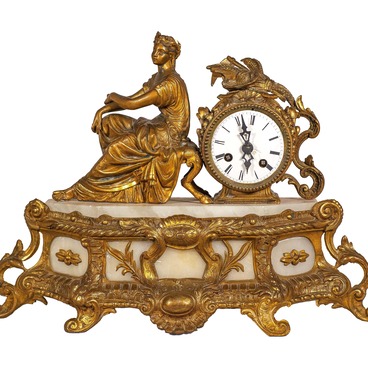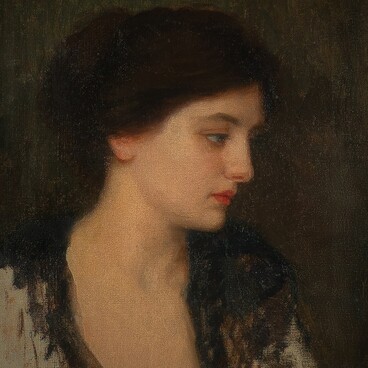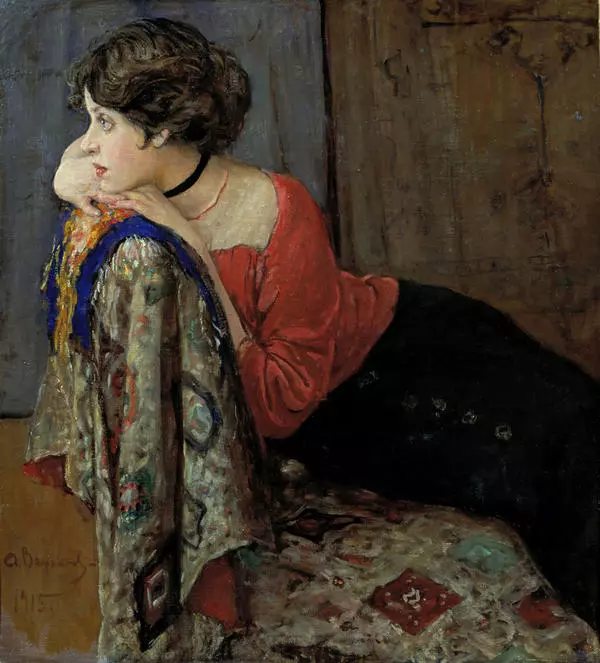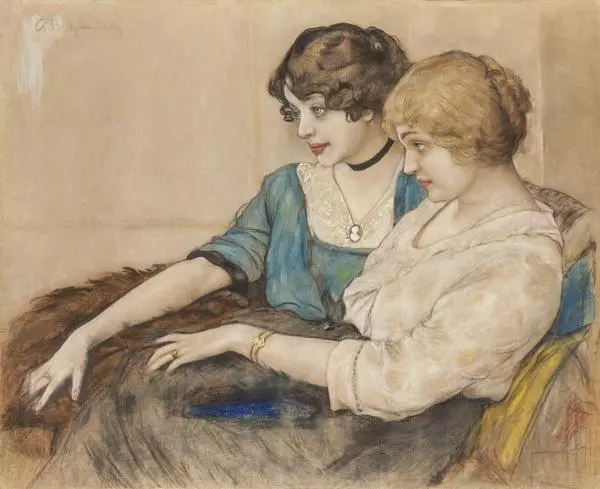The collection “The Old Mansion” contains a painting by Alexander Vakhrameev “Portrait of a Young Woman in a White Dress”.
Alexander Vakhrameev was born in a family of a clergyman in the village of Permogorye, Vologda governorate in 1874. He graduated from the Arkhangelsk Theological Seminary and after that began studying under Ilya Repin at the Drawing School of Princess Mariya Tenisheva. In 1896, Vakhrameev entered the Higher Art School at the Imperial Academy of Arts. He was awarded the title of an artist for his painting “Triumph of the Spirit (Self-immolation of the Old Believers)”.
Vakhrameev was a regular participant in academic exhibitions and presented his works at the exhibitions of the Association of Artists of Revolutionary Russia. His drawings were published by the Petersburg magazines “Shut”, “Gamayun”, and “Vesna”.
In 1906, the artist moved to Penza, where he began teaching at the Penza Art School named after Konstantin Savickiy. However, in 1909, he was accused of spreading “illegal” revolutionary ideas. Vakhrameev had to leave the city and return to St. Petersburg. In the capital, he painted a series of paintings dedicated to the revolutionaries: “Semenovets (Retribution)”, “Dispersal of a Student Demonstration near the Kazan Cathedral” and others.
At the invitation of Nicholas Roerich, the painter taught at the school of the Society for the Encouragement of Arts. In 1920 — 1925, he became a teacher and then a professor at the Academy of Arts.
Among the works of Alexander Vakhrameev are portraits, landscapes, as well as genre paintings with subjects that the artist saw on the streets of Petrograd: “Date on the Moyka”, “Street”, “In a Tavern”, “Policemen”. Vakhrameev’s works are presented in the Tretyakov Gallery, the Russian Museum, and other major collections of the country.
The artist painted the canvas “Portrait of a Young Woman in a White Dress” in the early 20th century. According to the compositional structure and manner of painting, art critics attribute this picture to the Art Nouveau style with its bizarre, elongated, stem-like lines. The silk fabric of the dress and the translucent lace on the sleeves are masterfully painted: a chaotic mixture of pink, green, and olive strokes turns into delicate lace and a puffy frill of the dress.
Alexander Vakhrameev was born in a family of a clergyman in the village of Permogorye, Vologda governorate in 1874. He graduated from the Arkhangelsk Theological Seminary and after that began studying under Ilya Repin at the Drawing School of Princess Mariya Tenisheva. In 1896, Vakhrameev entered the Higher Art School at the Imperial Academy of Arts. He was awarded the title of an artist for his painting “Triumph of the Spirit (Self-immolation of the Old Believers)”.
Vakhrameev was a regular participant in academic exhibitions and presented his works at the exhibitions of the Association of Artists of Revolutionary Russia. His drawings were published by the Petersburg magazines “Shut”, “Gamayun”, and “Vesna”.
In 1906, the artist moved to Penza, where he began teaching at the Penza Art School named after Konstantin Savickiy. However, in 1909, he was accused of spreading “illegal” revolutionary ideas. Vakhrameev had to leave the city and return to St. Petersburg. In the capital, he painted a series of paintings dedicated to the revolutionaries: “Semenovets (Retribution)”, “Dispersal of a Student Demonstration near the Kazan Cathedral” and others.
At the invitation of Nicholas Roerich, the painter taught at the school of the Society for the Encouragement of Arts. In 1920 — 1925, he became a teacher and then a professor at the Academy of Arts.
Among the works of Alexander Vakhrameev are portraits, landscapes, as well as genre paintings with subjects that the artist saw on the streets of Petrograd: “Date on the Moyka”, “Street”, “In a Tavern”, “Policemen”. Vakhrameev’s works are presented in the Tretyakov Gallery, the Russian Museum, and other major collections of the country.
The artist painted the canvas “Portrait of a Young Woman in a White Dress” in the early 20th century. According to the compositional structure and manner of painting, art critics attribute this picture to the Art Nouveau style with its bizarre, elongated, stem-like lines. The silk fabric of the dress and the translucent lace on the sleeves are masterfully painted: a chaotic mixture of pink, green, and olive strokes turns into delicate lace and a puffy frill of the dress.







